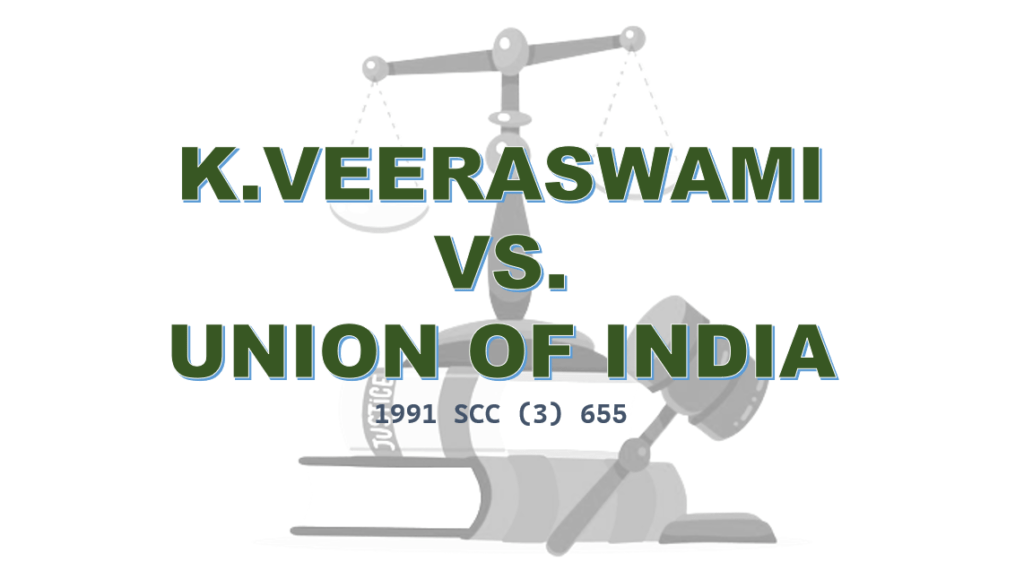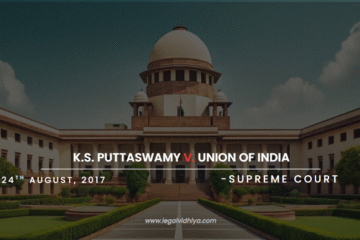
EQUIVALENT CITATIONS: 1991 SCR (3) 189, 1991 SCC (3) 655
DATE OF JUDGMENT – 25/07/1991
COURT: SUPREME COURT OF INDIA
PETITIONER: K. VEERASWAMI
RESPONDENT: UNION OF INDIA AND OTHERS
THE JUDGES’ BENCH: Ray, B.C. (J), Shetty, K.J. (J), Sharma, L.M. (J), Venkatachalliah, M.N. (J), Verma, Jagdish Saran (J)
BACKGROUND OF THE CASE
The case of K. Veeraswami vs. Union of India holds a special ground in judiciary. The case states about the prosecution of a judge with the prevention of corruption act 1947 in relation to it.
The Supreme Court decided that prior written consent of the Chief Justice of India is obligatory for any proceedings concerning the prosecution of a judge of a High Court or the Supreme Court to be commenced in the Parliament. The Veeraswami case holds well on the judicial side as it gave an upper hand to the judges.
FACTS OF THE CASE
A grievance or a complaint against the appellant, a former Chief Justice of a High Court, was made to the CBI on which a case under section 5(2) read with section 5(I) (e) of the Prevention of Corruption Act, 1947 was enumerated on 24.2.1976 and an F.I.R was the filed in the court of Special Judge on 28..2.1976.
The appellant advanced on leave from 9.3.1976 and retired on 8.4.1976 on attaining the age of superannuation.
Then Investigation was culminated and a charge sheet was filed against the appellant on 15.12.1977 before the Special Judge. The Charge sheet specified that the appellant after assumed the office of the Chief Justice on 1st may 1969and then gradually begun accumulation of moneys and wealth and was in the possession of pecuniary resources and property, in his name and in the names of his wife and two sons, inconsistent to his known sources of income for the period between the date of his appointment as Chief Justice and the date of registration of the case, and thereby he committed the offence of criminal misconduct under s. 5( 1 )(e), punishable under s.5(2) of the Prevention of Corruption Act, 1947.
The Special judge handed out process for appearance of the appellant. Meanwhile, the appellant moved the High Court under s. 482, CrPC. to put down the said criminal proceedings.
The matter was heard by a Full Bench of the High Court which dismissed the application by 2:1 majority; but approved a certificate under Articles 132(1) and 134(1)(c) of the Constitution of India in view of the important question of law involved. The matter was then discussed in the Supreme Court of India.
ISSUES INVOLVED[1]
- Whether a judge of a High Court or of the Supreme Court is a ‘public servant’ within the meaning of s. 2 of the Prevention of Corruption Act, 1947?
- Whether a Judge of the High Court including Chief Justice or a Judge of the Supreme Court can be prosecuted for an offence under the Prevention of Corruption Act, 1947?
- Who is the competent authority to remove a Judge either of the Supreme Court or High Court from his office in order to enable that authority to grant sanction for prosecution of the Judge under the provisions of section 6 of the Prevention of Corruption Act, 1947?
ARGUMENTS OF PETITIONER
The petitioner asserted that the provisions of the Prevention of Corruption Act, 1947 do not apply to a judge of a superior Court as for such prosecution.
The previous sanction of an authority competent to remove a public servant as stated under section 6 of the Prevention of Corruption Act, 1947 is imperative and power to remove a Judge is not vested in any single individual authority.
But it is vested in the two Houses of Parliament and the President under Article 124(4) of the Constitution that the Parliament cannot be the sanctioning authority for the purpose of section 6 and if the President is regarded as the authority, he cannot act independently as he exercises his powers by and with the advice of his Council of Ministers and the Executive may ‘misuse the power by interfering with the judiciary that section 6 applies only in cases where there is master and servant relationship between the public servant and the authority competent to remove him, and where there is vertical hierarchy of public offices and the sanctioning authority is vertically superior in the hierarchy in which office of the public servant against whom sanction is sought exists and that no prosecution can be launched against a Judge of a superior Court under the provisions of the Prevention of Corruption Act except in the mode envisaged by Article 124(4) of the Constitution.[2]
He also argued that no law prohibits a public servant having in his possession assets disproportionate to his known sources of income and such possession becomes an offence only when the public servant is unable to account for it and that the public servant is authorized to an opportunity by the investigating officer to explain disproportionality between the assets and the known sources of income and the charge sheet must contain such an averment, and failure to mention that requirement would vitiate the charge-sheet and render it invalid and no offence under section 5(1)(e) of the Act could be made out.
ARGUMENTS OF RESPONDENT
In this case the respondent depended on the investigation administered by the CBI as well as on the charge sheet filed by them and had evidence as to the disproportionate sources of income of the appellant to which the appellant does not deny .
Hence there were no arguments by them. The only query they had, is the competent authority to decide on the case.
JUDGEMENTS
1. Within the meaning of section 2 of the Prevention of Corruption Act, 1947, a Judge of a High Court or of the Supreme Court is a ‘public servant’
2. As envisaged by section 6 of the Prevention of Corruption Act, 1947, prosecution of a Judge of a High Court, including the Chief Justice or a Judge of the Supreme Court can be launched after obtaining sanction of the competent authority.
Verma, J. (dissenting)–
Judge or Chief Justice of a High Court is a Constitutional functionary, even though he holds a public office and in that sense he may be included in the wide definition of a public servant. But a public servant whose category for the grant of sanction for prosecution is not envisaged by s. 6 of the Act is outside the purview of the Act, not intended to be covered by the Act. The Prevention of Corruption Act, 1947, as amended by the 1964 amendment is inapplicable to Judges of the High Courts and the Supreme Court.*[3]
(Per Majority–Ray, Shetty and Venkatachalliah, JJ.)*[4]
1. For the purpose of s. 6(1)(c) of the Prevention of Corruption Act, 1947, the President of India is the authority competent to give previous sanction for prosecution of a Judge of a superior Court.
2. No criminal case shall be registered under s. 154, Cr. P.C. against a Judge of the High Court, Chief Justice of the High Court or a Judge of the Supreme Court unless the Chief Justice of India is consulted in the matter.
3. If the Chief Justice of India himself is the person against whom the allegations of criminal misconduct are received, the Government shall consult any other judge or Judges of the Supreme Court.
4. There shall be similar consultation at the stage of examining the question of granting sanction for prosecution and it shall be necessary and appropriate that the question of sanction be guided by and in accordance with the advice of the Chief Justice of India.
Verma. J. (dissenting)
Section 6 of the Act is inapplicable to Judges of High Courts or of the Supreme Court and such Constitutional functionaries do not fail within the purview of the Prevention of Corruption Act, 1947*[5]
EFFECT OF THE JUDGEMENT
An essential was felt for a law to be enforced or enacted, which provides for punishment of a superior Judge who is charged with the criminal misconduct of corruption by misuse of his office.
The Parliament is the sole arbitrator. And so it was necessary for the Parliament to step in and enact suitable legislation in consonance with the constitutional scheme which provides for preservation of the independence of judiciary and to expand the field of operation of the existing law to shield the superior Judges by usurping the legislative function of enacting guidelines since without the proposed guidelines the existing legislation cannot apply to them.
CONCLUSION
The Supreme Court has set an important rule following the case of K.Veeraswami vs. Union of India .There is really a need for an authority competent to remove the Judges of the subordinate, High court and Supreme Court under this Act.
It can be agreed with the view of dismissing the appeal since there was no authority who can grant the sanction for prosecution in case of criminal misconduct and taking no action except from removal of the Judge is also not appropriate.
A penalty is also needed to be set and the Judge being a public servant, even harsher punishments need to be ratified. Since it is in a way not acceptable that the judge would go for an act of corruption.
This is written by Nandini Saikia of University Law College, Gauhati University, an intern under Legal Vidhiya
[1] Harshita khandelwal, Case Recap: K. Veeraswami vs. Union Of India And Others, available at https://legaldesire.com/case-recap-k-veeraswami-vs-union-of-india-and-others/, last seen on 15/04/2023.
[2] Harshita khandelwal , Case Recap: K. Veeraswami vs. Union Of India And Others, available at https://legaldesire.com/case-recap-k-veeraswami-vs-union-of-india-and-others/, last seen on 15/04/2023
[3] Harshita khandelwal , Case Recap: K. Veeraswami vs. Union Of India And Others, available at https://legaldesire.com/case-recap-k-veeraswami-vs-union-of-india-and-others/, last seen on 15/04/2023
[4] Ibid.
[5] Harshita khandelwal , Case Recap: K. Veeraswami vs. Union Of India And Others, available at https://legaldesire.com/case-recap-k-veeraswami-vs-union-of-india-and-others/, last seen on 15/04/2023




0 Comments